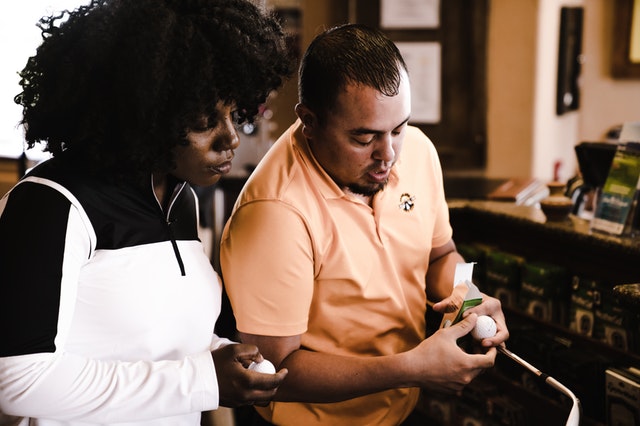This article is written and produced by Sue Shapcott, PhD. Sue is the founder of Change Golf Instruction, a golf coaching business that partners with public golf courses, and Sports Query, a consulting business that assists sports organizations incorporate social science into their policies and practices. Sue is based in Madison, WI.
Club staff, including managers and coaching professionals can, over time, become immunized to the customer experience and the various touch points that form it. Guest writer, Sue Shapcott, reveals how clubs should take the time to understand this experience – and why it’s crucial when it comes to attracting women, minorities and families.
Without knowing it, club staff can be reinforcing an experience that is off-putting and unwelcoming to prospective members and (current) minority groups.
In a male-dominated sport such as golf, gender stereotypes play a significant role in shaping and affirming people’s views of a club – particularly women.
Think about it: walking in to see a large group of men congregated at the bar, being greeted with a wall of products for men in the golf shop, clubhouse walls adorned with pictures of men in quintessential golfing attire. All of these cues serve to induce stereotype threat. Stereotype threat, by definition, is the demotivation someone may feel when they identify with a negatively stereotyped social group. The traditional golf environment, unfortunately, is likely to induce stereotype threat in women, children and minorities because it underscores who is, and who isn’t a typical golfer.
As well as inducing stereotype threat, the golf club environment will also impact the sense of belonging women and minority groups experience in traditional golf clubs. Conforming to a club’s traditions means accepting this ecosystem which may feel unfair, unbalanced, and ‘just the way it is (and has always been)’.
But importantly for clubs seeking new members, these groups are making a choice based on their experience at that club. Is this somewhere they visualize spending time (with their family)? Do they want to spend time here? Does it have the potential to become a core part of their life or lifestyle?
If they feel forced to conform, and conforming means signing up to an experience that will not enhance their lifestyle, then, simply put, they will not.
Why does it matter?
Removing stereotype threat experienced by women and minority golfers can be a difficult challenge for many clubs out there. It can mean unpicking a culture which, understandably, takes time.
But allowing the cycle to continue will restrict growth and diversity in your current membership base, as well as your prospective target markets – especially at a time when we know younger generations value family time together. So much so they will base purchasing decisions on how these will enhance their collective lifestyle.
Where to start
Shifting the culture starts by seeing the world through the eyes of women and minority groups.
Accompany existing and prospective members on a customer walkthrough and all of a sudden, things will become more apparent. You’ll quickly see what and why things need to change. For example, does your leadership team look like the face of golf’s past, or future? Does the club have photos that celebrate both men and women players?
Unite all the club staff around this process. Educate them on the prevalence of stereotypes, and their effect. You can then arm staff with the knowledge they need to neutralize the environment. Tackling the issue in unison will ensure that staff are conscious and aware, and there are no gaps in the club’s approach.
What areas can you expect to confront and overcome stereotype threat typically experienced by women and minority golfers? Here are some areas which are common, yet often overlooked:
Marketing – if you market to the spouses of existing members what images and/or videos are you choosing to include? What is that telling them about the club? Chances are, you could be confirming stereotypes without realizing it. It’s not about provisioning certain types of images and videos ‘because it’s the right thing to do’. It’s about doing it because clubs need to understand their influence and not inadvertently confirm certain stereotypes – especially when it will harm their goals in the long run.
Coaching – coaches should make it clear to women that they have a high expectation of their ability and performance (dispelling the stereotype that women are somehow not as strong in their ability).
Clubhouse – a contemporary environment which suits the needs of all members is what clubs should strive for. Remove unnecessary imagery which serves to reaffirm certain stereotypes and make it a place where all profiles of member can enjoy, relax and spend time.
Golf Shop – being greeted by rows of hardware, mainly for men, can be a daunting experience – especially so for women new to the game. Make service your priority, and dispel any fears minority groups may have by handing them the knowledge they need to make informed purchasing decisions.
On the course – tees labelled by gender are extremely commonplace, yet are a constant reminder that women don’t hit the ball as far and that this somehow makes their ability inferior. By changing your tees to difficulty-based rather than gender-based creates more of a level playing field and removes the gender factor and associated stereotype threat.
A rallying call
Change at clubs is always difficult when there’s a threat of alienating a certain group – in this case the core membership. But this is where it’s important to take a step back and assess the fork in the road in which we find ourselves:
Road A: We do the same thing. Members age, member numbers recede, and the cycle of stereotype threat experienced by women and minorities continue.
Road B: We open up, we see our club differently, we remove stereotype threats and create an environment a more diverse range of prospects want to be a part of.
As a stakeholder in this industry, I know which future I would rather be a part of.



